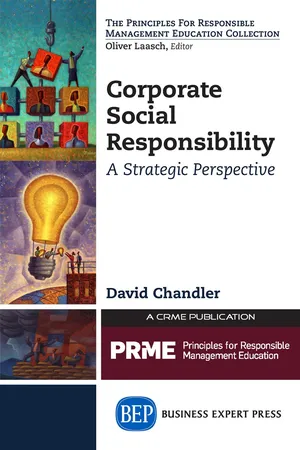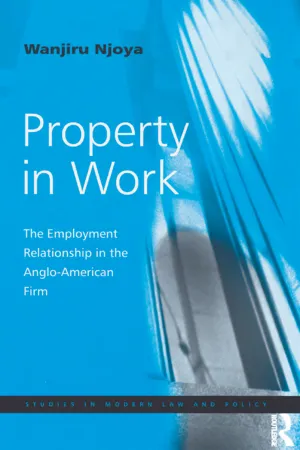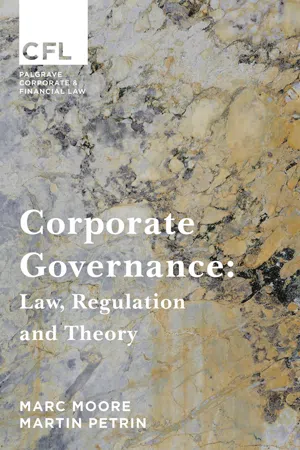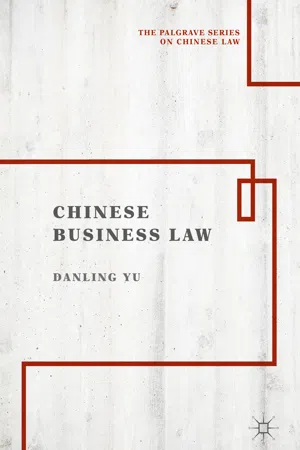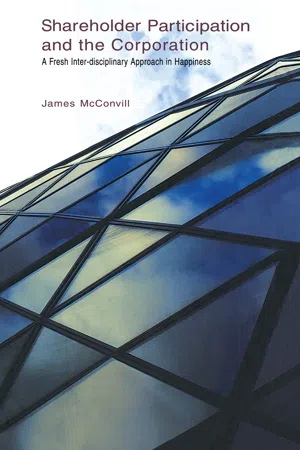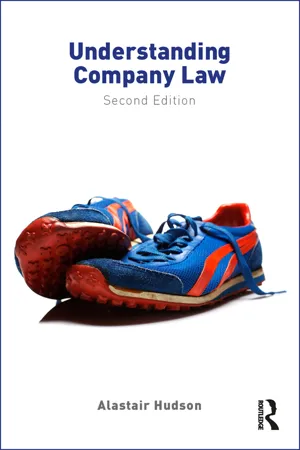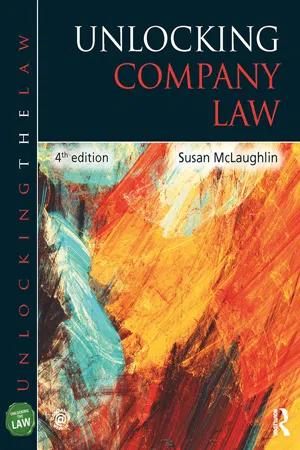Business
Shareholder
A shareholder is an individual, company, or institution that owns shares in a corporation. Shareholders have ownership rights in the company and are entitled to a portion of its profits, as well as the right to vote on certain company decisions. They also bear the risk of financial loss if the company performs poorly.
Written by Perlego with AI-assistance
9 Key excerpts on "Shareholder"
- eBook - ePub
- David Chandler(Author)
- 2014(Publication Date)
- Business Expert Press(Publisher)
A share is a legal contract between the investor and the firm in the same way that employees, suppliers, and others hold legal contracts with the firm. What is becoming increasingly clear is that, while stockholders invest capital in companies (in the same way that employees invest time, effort, and skills), they have no greater claim to ownership of those companies than other stakeholders. 21 And, there is a growing number of commentators, such as Martin Wolf in the Financial Times, who believe their claim is significantly less than other stakeholders: The economic purpose of property ownership is to align rights to control with risk-bearing. The owner of a corner shop should control the business because she is also its chief risk-bearer. Risk, reward and control are aligned. Is it true that the chief risk-bearer in [a publicly-traded corporation] is the Shareholder? Obviously not. All those who have stakes in the company that they are unable to hedge bear risks. The most obvious such risk-bearers are employees with firm-specific skills. . . . Shareholders, in contrast, can easily hedge their risks by purchasing a diversified portfolio. 22 Essentially, being a Shareholder entitles the owner of that share to a few specific and highly limited rights: They are able to vote (although the practical application of Shareholder democracy is weak and narrow); they are able to receive dividends (only as long as the firm is willing to issue them); and they are able to sell their share to a third-party at a time of their choosing. These rights constitute a contractual relationship between the firm and the Shareholder, but do not constitute ownership - eBook - ePub
- David Chandler(Author)
- 2020(Publication Date)
- Routledge(Publisher)
20Shareholders own shares – a legal contract between the investor and the firm similar to employees, suppliers, and others who also hold legal contracts with the firm. What is becoming increasingly clear is that, while stockholders invest capital in firms (in the same way employees invest time, effort, and skills), they have no greater claim to ownership of those firms than other stakeholders.21 And, there is a growing number of commentators, such as Martin Wolf in the Financial Times, who believe their claim is significantly less than other stakeholders:The economic purpose of property ownership is to align rights to control with risk-bearing. The owner of a corner shop should control the business because she is also its chief risk-bearer. Risk, reward and control are aligned. Is it true that the chief risk-bearer in [a publicly-traded corporation] is the Shareholder? Obviously not. All those who have stakes in the company that they are unable to hedge bear risks. The most obvious such risk-bearers are employees with firm-specific skills. … Shareholders, in contrast, can easily hedge their risks by purchasing a diversified portfolio.22Essentially, being a Shareholder entitles the owner of that share to a few specific and highly limited rights: they are able to vote (although the practical application of Shareholder democracy is weak and narrow); they are able to receive dividends (only as long as the firm is willing to issue them); and they are able to offer their share for sale to a third-party at a time of their choosing. These rights constitute a contractual relationship between the firm and the Shareholder, but do not constitute ownership. As noted by Eugene Fama, one of the originators of the agency theory of the firm, “Ownership of capital should not be confused with ownership of the firm.”23 - eBook - ePub
Property in Work
The Employment Relationship in the Anglo-American Firm
- Wanjiru Njoya(Author)
- 2016(Publication Date)
- Routledge(Publisher)
19Shareholder and Stakeholder Owners
Because Shareholders are often referred to as ‘owners’ of the firm the framework of corporate governance is premised on the idea that managers act on behalf of and are accountable to the Shareholders.20 At a general level the argument that the corporation belongs to its Shareholders may be readily appreciated. The Companies Act 1985 defines the members of the company as its Shareholders.21 It appears logical that the Shareholders’ purchase of shares in the company gives them an ownership stake within it. Shares are a valuable, indeed arguably the most valuable, form of property in the modern economy, having long surpassed the importance of land ownership.22 The property rights theory of the firm defines ownership as ‘possession of “residual” control rights, the rights to make all decisions (at least those that have not been delegated to others by contract) and receive whatever is left over after all payments specified by contract have been paid’.23 Drawing from this definition it seems reasonable to describe Shareholders as the firm’s owners, as all control rights vest in them other than those they delegate to managers to exercise on their behalf. In contrast to claims of Shareholder ownership, it is more difficult to discern the basis of the employees’ claim to ownership. After all it could be said that the workers are simply hired by the company to do a specific job for which they are paid, and that their interest in the firm stops there. Employees are deemed to be outsiders with whom the firm deals at arms’ length through the mechanism of contract: ‘a firm is a fairly well-defined entity whose interests are simply the interests of its owners. By this assumption, employees are contracting with the firm but are not, themselves, part of it’.24 - eBook - ePub
Corporate Governance
Law, Regulation and Theory
- Marc Moore, Martin Petrin(Authors)
- 2017(Publication Date)
- Hart Publishing(Publisher)
Financial Times, 22 April 2014 (quoting a former UK business secretary as saying ‘we will see how far [executives] have listened to pressure from the people who own the banks – the Shareholders’).29 [1925] AC 619.30 Short v Treasury Commissioners [1948] AC 534 (HL), per Evershed LJ.31 L. Sealy and S. Worthington, Cases and Materials in Company Law (10th ed., OUP 2013), 493. Shareholders’ rights to dispose of their shares are not unlimited. Although shares are usually freely transferable in public companies, restrictions for the sale of shares may apply in private companies. Additionally, Shareholders may agree to voluntary transfer restrictions in Shareholders’ agreements.32 See also Borland’s Trustee v Steel [1901] 1 Ch 279, where Farwell J noted that ‘[a] share is the interest of a Shareholder in the company measured by a sum of money, for the purpose of liability in the first place, and of interest in the second, but also consisting of a series of mutual covenants entered into by all the Shareholders inter se in accordance with [the constitution]’.33 See also section 541 of the Companies Act 2006, which describes the nature of shares in terms of a member’s personal property. In the UK, shares are conceptualized by reference to the property law concept of ‘choses in action’, that is property rights in something intangible, or which is not in one’s possession, but enforceable through legal or court action. For an in-depth discussion, including philosophical aspects, of the nature of shares and their ownership, see also P. Ireland, ‘Company Law and the Myth of Shareholder Ownership’ (1999) 62 Modern Law Review 32.34 See also the corresponding discussion in Chapter 2 on Shareholders’ residual risk-bearing role.35 J. Kay, The Kay Review of UK Equity Markets and Long-Term Decision Making: Final Report (July 2012), 32. On the main types of institutional Shareholder typically seen in UK public companies, see also the discussion in Chapter 5 - eBook - ePub
- Danling Yu(Author)
- 2018(Publication Date)
- Palgrave Macmillan(Publisher)
The Shareholders of a LLC may inspect the corporation’s articles of incorporation, resolutions of Shareholder meetings, resolutions of meetings of the board of directors, resolutions of the board of supervisors, financial and accounting reports as well as accounting records, and make copies thereof. Nonetheless, the right to know is not totally unrestricted. A corporation to be inspected may decline a request from a Shareholder if it finds any impropriety in such request that may harm the corporation.Another manifestation of a Shareholder’s right to participate in the management in the corporation is the right to sue. The law provides for this if any Shareholder has inflicted harm upon the interests of other Shareholders or the conduct of the senior management or the directors of the board has encroached upon the interests of the Shareholders. Under such circumstances, the Shareholder may exercise the right to sue.1.8 Corporate Finance
1.8.1 General Concept
The capital of a JSC may be divided into shares, with each share being of equal value. The smallest unit of capital of a corporation is one share . Shares come in the form of corporation stock, and can be either common or preferential. Shareholders vote according to the principle of one-share-one-vote and enjoy rights in proportion to the extent of their shareholding. Rights include the right to profit and the right to vote. The right to profit is the right to receive dividends and the right to receive a proportion of the residual property of the corporation upon liquidation. Normally, the rights associated with each type of share are more or less similar, but common Shareholders, however, may enjoy a wider range of rights. They have voting and decision-making rights with regard to major corporate affairs. Meanwhile, the right to profit held by common Shareholders may be exercised only after that of preferred Shareholders.The Company Law of 2014 does not , however, specifically provide for any preferred shares issued by a corporation. Article 132 empowers the State Council to stipulate other kind of shares other than common stocks in its rules and regulations. Preferred shares are, in fact, adopted in practice by Chinese corporations. The practice with regard to preferred shares is rather similar to that in the civil law countries and common law countries. Preferred Shareholders are given preference over common Shareholders in profit - eBook - ePub
Shareholder Participation and the Corporation
A Fresh Inter-Disciplinary Approach in Happiness
- James McConvill(Author)
- 2020(Publication Date)
- Routledge-Cavendish(Publisher)
23I respectfully disagree with both views. Shares do in fact constitute a proprietary interest in the corporation, with the corollary being that Shareholders are the owners of the corporation, and the reasoning behind this view is neither complex or sophisticated — it simply reflects what should be an indisputable fact: a corporation, like a house, has a distinct legal form,24 and while a house is a tangible entity comprised of (among other things) bricks and mortar, a corporation is an intangible entity, existing only on paper, and built not from materials and labour, but from a collection of shares in the name of particular individuals or organisations. Thus, while it is undisputed, both in the general community and at law, that the person who owns the house, by connection owns the bricks used to build the house, so it should be an undisputed fact that the individuals who own the shares of a corporation are the owners of the corporation.It can be presumed that the issue that stands in the way of commentators being able to accept that shares do in fact meet the description of property, just like a house, boat, car or corporate governance textbook, aside from shares having an intangible quality, is that unlike (it is also presumed) other things that we traditionally associate with the concept of property, the rights of Shareholders in relation to their shares are narrowly cast and quite dependent on a third party — the board of directors. While it may be said that Shareholders own the shares, and hence the corporation, they do not have any rights over the assets of the corporation — all they are entitled to is a share of the company’s profits via dividend payments — and then only when the directors consider that it is appropriate that these payments are made.25 It is in this sense that shares are referred to as ‘autonomous’.26 - eBook - ePub
- Steven Scalet(Author)
- 2018(Publication Date)
- Routledge(Publisher)
An historically important feature of Shareholder rights is a legal principle of limited liability, which means that Shareholders are typically immune from paying any debts of the corporation beyond their initial investment in purchasing shares. This immunity has helped corporations raise large sums of money from investors whose personal finances are legally protected from corporate debt collectors. The property concepts introduced in Chapter 2 (claims, liberties, powers, and immunities) are important for investigating the complex property rights of corporations; the field of corporate law is the study of the financial and governance functions of corporations as defined by the state. Although we need not investigate the legal structure of corporations beyond this bare outline for the arguments ahead, it’s worth noting that businesses take other legal forms as well, such as sole proprietorships, partnerships, and cooperatives. These businesses include one or more owners who are typically liable for any debts incurred by the firm’s activities and they generally control the business with extensive claims, liberties, and powers over all aspects of its operations. In the case of a corporation, the top management runs the business but does not own it—that’s the role of the Shareholders. Most business corporations are small, but some are large—so large that people struggle to understand and characterize the purpose, role, and scope of these enormous institutions. Consider, “What is the largest economic entity in the world?” In 2016, measured by gross domestic product (GDP), the United States is first, followed by Japan, China, and Germany. Any guesses about No. 10? It’s not a nation-state at all—it’s Walmart - eBook - ePub
- Alastair Hudson(Author)
- 2017(Publication Date)
- Routledge(Publisher)
Shareholders’ rightsIntroduction
This chapter is concerned with the rights of Shareholders. The greater part of this chapter is concerned with the way in which minority Shareholders can protect themselves against the actions of the majority. This is at the heart of the law on Shareholder rights because the basic proposition is that the majority Shareholders can vote for whatever they want, and therefore the most interesting legislation and case law have related to the minority Shareholders trying to resist a decision of the majority. Two further issues are also considered: first, the power to remove directors and, second, the legal basis on which dividends are paid to Shareholders. Chapter 4 considered the rights of Shareholders as they relate specifically to the company’s constitution.At the outset, we should remind ourselves of how a company functions in practical terms, and how company law interacts with that. In Chapter 6 we considered the operation of the company, and in Chapter 5 we considered the various forms of shareholding in the company. In those chapters we learned that different classes of Shareholder have different types of rights and also that a large part of the company’s business is conducted formally at the annual general meeting. Otherwise, the company is controlled on a day-to-day basis by the directors (and other senior management outside the board of directors if it is a large company).The operation of any trading company will involve making choices between, for example, investing for the long-term benefit of the business or generating short-term profits that can be distributed among the Shareholders. Therefore, there may be situations in which individual Shareholders, or even groups of Shareholders, feel that they have been badly treated either by the directors or by the votes of other Shareholders. For example, the directors may wish to retain a year’s profit in the business to invest in its future growth, instead of paying it out to the Shareholders in dividends; whereas some of the Shareholders may prefer to have that profit paid out so that they can receive dividends out of those profits in the short term. This will clearly generate conflict between directors and Shareholders, or between different groups of Shareholders. Different groups of Shareholders may have different opinions as to the best future for the company and therefore one group of Shareholders may vote at an annual general meeting for a course of action that is harmful to the interests of another group of Shareholders. Again, this will generate conflict. - eBook - ePub
- Susan McLaughlin(Author)
- 2018(Publication Date)
- Routledge(Publisher)
7 Shareholders, shares and share capital AIMS AND OBJECTIVES After reading this chapter you should be able to: ■ Understand the legal nature of a share and the rights and liabilities of a Shareholder ■ Explain the concept of a class of shares ■ Distinguish equity and non-equity shares ■ Discuss what is and what is not a variation of rights ■ Use the language of share capital accurately ■ Discuss why and how a company may increase its share capital ■ Discuss the role of pre-emption rights and when they are applicable ■ Identify which companies may offer shares to the public and when a prospectus is required 7.1 Introduction This chapter is divided into six sections. The next section examines the fundamental financial entitlements of ordinary Shareholders and the corresponding risk of losing the value of their investment in a company. The third section examines the legal nature of a share, the rights attached to different classes of shares and variation of class rights. The fourth section examines the language and structure of the share capital of a company and section five examines how to increase a company’s share capital. Reducing a company’s share capital is a far more problematic step than increasing it and is dealt with in the next chapter, as part of our study of capital maintenance. The final section outlines offering shares to the public. 7.2 Shareholders 7.2.1 Who is entitled to the residual wealth of a company? A company operating a business for profit owns the business assets. In Salomon v A Salomon and Co Ltd [1897] AC 22 (HL), the company owned the shoe manufacturing business. A company that operates a successful business makes profits and those profits belong to the company. Profits may be retained and re-invested to expand the business. This increases the value of the company’s business assets and allows the company to generate bigger profits. If this happens, the company becomes wealthier. Yet the company is an artificial person
Explore more topic indexes
Explore more topic indexes
1 of 6
Explore more topic indexes
1 of 4
